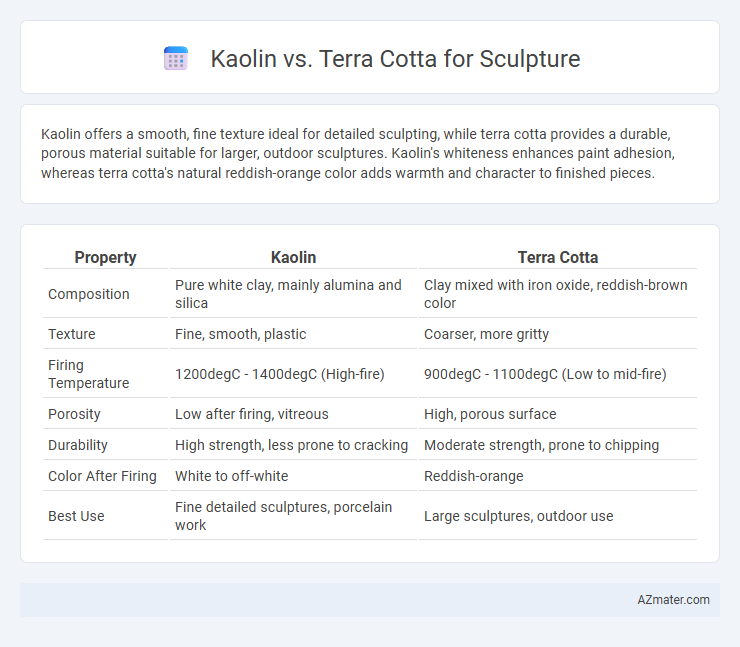Kaolin offers a smooth, fine texture ideal for detailed sculpting, while terra cotta provides a durable, porous material suitable for larger, outdoor sculptures. Kaolin's whiteness enhances paint adhesion, whereas terra cotta's natural reddish-orange color adds warmth and character to finished pieces.
Table of Comparison
| Property | Kaolin | Terra Cotta |
|---|---|---|
| Composition | Pure white clay, mainly alumina and silica | Clay mixed with iron oxide, reddish-brown color |
| Texture | Fine, smooth, plastic | Coarser, more gritty |
| Firing Temperature | 1200degC - 1400degC (High-fire) | 900degC - 1100degC (Low to mid-fire) |
| Porosity | Low after firing, vitreous | High, porous surface |
| Durability | High strength, less prone to cracking | Moderate strength, prone to chipping |
| Color After Firing | White to off-white | Reddish-orange |
| Best Use | Fine detailed sculptures, porcelain work | Large sculptures, outdoor use |
Introduction to Kaolin and Terra Cotta
Kaolin, a pure white clay composed primarily of kaolinite, is prized in sculpture for its fine texture and smooth finish, allowing detailed work and delicate forms. Terra cotta, made from natural clay mixed with iron oxide, offers a reddish-brown hue and is favored for its durability and earthy aesthetic in outdoor and large-scale sculptures. Both materials provide distinct tactile qualities and firing characteristics, making them essential choices in ceramic art and sculptural craftsmanship.
Composition and Material Properties
Kaolin is a fine, white clay primarily composed of the mineral kaolinite, known for its purity, plasticity, and smooth texture, making it ideal for detailed sculpting and fine ceramic work. Terra cotta consists mainly of iron-rich clay mixed with sand and other natural impurities, resulting in a coarser texture and reddish-brown color after firing, which is favored for its durability and earthy aesthetic in larger, outdoor sculptures. The lower firing temperature of terra cotta retains porousness, while kaolin's higher firing temperature produces a vitrified, denser surface, influencing the sculpture's weight, strength, and finish quality.
Workability and Sculpting Techniques
Kaolin offers superior workability for fine detail and smooth textures due to its pure, fine-grained composition, making it ideal for intricate sculpting techniques like carving and modeling. Terra cotta, with its coarser texture and higher plasticity, excels in hand-building methods such as coiling and slab construction, providing durability and warmth in finished pieces. Both clays respond well to traditional sculpting tools, but kaolin's refined consistency allows for sharper edges and delicate features compared to terra cotta's rustic, organic finish.
Firing Temperatures and Methods
Kaolin clay typically requires a higher firing temperature, around 1200-1300degC, making it suitable for porcelain and fine ceramic sculptures with smooth, white finishes. Terra cotta clay fires at lower temperatures, generally between 900-1100degC, producing a porous, reddish-brown material ideal for rustic or traditional sculpture forms. Firing methods for kaolin often involve high-temperature electric or gas kilns, while terra cotta can be successfully fired in wood or pit kilns, allowing for more varied surface textures.
Surface Texture and Finish
Kaolin clay offers a smooth, fine-grained surface texture ideal for detailed sculpture work and can achieve a polished, porcelain-like finish after firing. Terra cotta has a coarser, more porous texture that imparts a rustic, earthy appearance, commonly left unglazed or finished with a matte patina. The choice between kaolin and terra cotta significantly impacts the tactile quality and visual aesthetics of ceramic sculptures.
Strength and Durability
Kaolin clay offers a finer grain and higher plasticity, resulting in sculptures with delicate details but lower overall strength compared to terracotta. Terra cotta, fired at higher temperatures, becomes denser and more durable, making it better suited for outdoor or structural sculptures. Its enhanced strength and weather resistance ensure longevity, whereas kaolin's brittleness limits its use to indoor or finely detailed pieces.
Color and Aesthetic Differences
Kaolin clay exhibits a pure white color that provides a smooth, refined surface ideal for detailed sculptures and glazing, while terra cotta is characterized by its warm, reddish-brown hue resulting from iron oxide content, offering a rustic and earthy aesthetic. The color differences influence the final appearance, with kaolin enabling bright, crisp finishes and terra cotta delivering natural, organic tones that age beautifully over time. Sculptors often choose kaolin for polished, porcelain-like works and terra cotta for traditional, robust sculptures emphasizing texture and warmth.
Cost and Availability
Kaolin clay is generally more expensive due to its fine, pure composition and limited sources, making it less accessible for large-scale sculptures. Terra cotta clay is widely available and cost-effective, favored for its natural iron content that provides a warm reddish-brown finish. Sculptors choose terra cotta when budget constraints and ease of access are critical, while kaolin is selected for detailed, high-quality finishes despite higher costs.
Environmental Impact and Sustainability
Kaolin, a primary clay mineral, offers higher purity and less environmental degradation due to its selective mining and lower processing energy compared to terra cotta, which often involves extracting mixed clays causing more landscape disruption. Terra cotta's firing process typically requires higher temperatures, increasing carbon emissions, while kaolin ceramics can be fired at relatively lower temperatures, reducing overall energy use. Sustainability in sculpture favors kaolin for its cleaner extraction and energy-efficient production, though terra cotta remains valued for its natural, biodegradable properties when sourced responsibly.
Best Uses: Choosing the Right Clay for Your Sculpture
Kaolin offers a fine, white clay ideal for detailed, smooth sculptures and porcelain finishes, making it best for delicate, high-quality art pieces. Terra cotta, with its coarse texture and rich reddish-brown color, suits robust, outdoor sculptures and traditional pottery due to its durability and natural aesthetic. Selecting the right clay depends on the desired finish, structural strength, and firing temperature requirements specific to your sculpture project.

Infographic: Kaolin vs Terra Cotta for Sculpture
 azmater.com
azmater.com